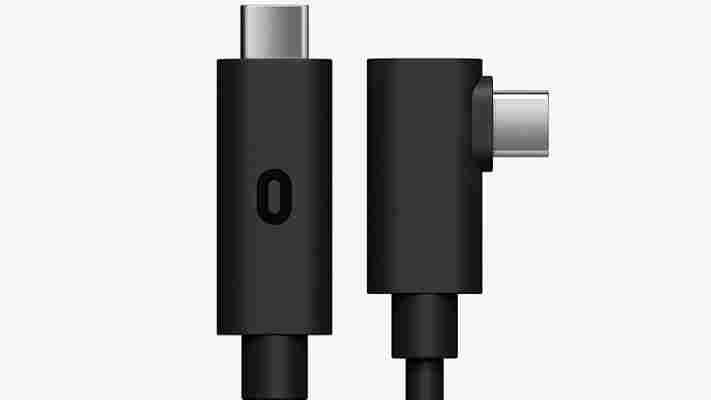
Meta could soon make the Oculus Quest 2 (now Meta Quest 2) an even better headset for PC VR thanks to a secretive device known as ‘Air Bridge.’
References to the unannounced ‘D-Link DWA-F18 VR Air Bridge’ were found by software engineer ItsKaitlyn03 in the latest Quest PC drivers for the Public Test Channel (later verified by UploadVR ). Based on its name, many believe this could be a wireless dongle designed to improve the performance of the Quest 2’s Air Link feature – which lets you play PC VR games without a cable.
The Air Bridge sounds like a device designed to connect two devices over a wireless connection, and its name hints at links to the Quest 2’s Air Link abilities. Its DWA-F18 name is also identical to the form used by USB Wi-Fi dongles like the DWA-X1850 .
Meta has yet to announce anything officially, but with the Meta Quest Gaming showcase coming on April 20 there’s a chance the company could unveil some new gaming hardware alongside the software headed to its Quest 2 VR platform.
Until an announcement comes, though, here’s everything we currently know about Meta’s Air Bridge, as well as why it could be a must-have device for Quest 2 players.
This dongle could be exactly what’s needed to turn Air Link from ‘Experimental’ to a fully-fledged feature.
Currently, Air Link works over Wi-Fi, but this has a few issues. Rather than interfacing with your computer directly, the signal has to pass through your router first and will be impacted by your network’s load, along with walls and objects placed between your router, PC, and Quest 2 headset that could block the signal.
As such, VR games played over Air Link are rarely as smooth as native Quest 2 games – resulting in Meta tagging the ability as ‘Experimental’, its codename for features that aren’t yet bug-free.
Players after a better connection could opt for the Link Cable, but the wire instantly removes the Quest 2's best feature – that it's completely untethered giving you complete freedom of movement.

A dongle, on the other hand, would remove some of these issues, as your Quest 2 headset and PC could interface directly on their own separate network. You’d still want to have your PC near your VR play space, but you won’t need to move your router around for the best experience – and you’ll no longer need to beg people to come off the Wi-Fi when you want to play wireless PC VR.
However, we’ll have to wait for Meta to make an official announcement before we get too excited. Firmware mentions are by no means a confirmation that a device is heading to consumers soon, if at all. Sure, it suggests Meta is testing some kind of dongle but it could decide the results don’t meet expectations and the plans are scrapped.
If it is coming our way, there’s a chance we could hear some mention of the Air Bridge at the Meta Quest Gaming Showcase on April 20.
The Air Bridge hasn’t been officially announced yet, so there’s no confirmation of its price yet – of if it'll become publicly available at all.
That said, we can make predictions based on what we do know. For starters, we reckon a price somewhere in the $30 to $60 range is most likely (£25 to £50 / AU$40 to AU$80). This is on par with devices like the DWA-X1850 Wi-FI USB dongle and would stick to the Quest 2’s promise of keeping VR relatively affordable.
For those who have enjoyed Air Links capabilities over Wi-Fi, another $30 to $60 wouldn’t be too much of an ask to upgrade your Quest 2’s performance – and we expect it would also work with the Quest 3 and Project Cambria when they are launched.
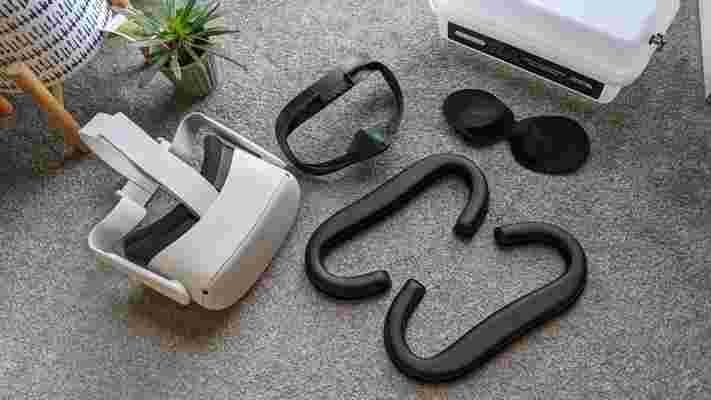
Much like price, we’re also in the dark about the device’s release date, but we can once again make some educated guesses.
An announcement at the April 20 Quest Gaming showcase would make a lot of sense, but with the device only just getting a reference in public test code, it could still be a little too soon.
As such, a release later in the year seems more likely. At last year’s Meta keynote, the company not only announced a name change but also revealed that two new VR headsets were coming soon.
If a similar event happens this year, we could see Meta not only firm up details on its Project Cambria headset, but also unveil peripherals like the Air Bridge that will help it deliver an even better VR experience than anything before.
Based on its naming style, the DWA-F18 VR Air Bridge will very likely look like a standard USB Wi-Fi dongle that's designed to plug directly into one of your PC ports.
Once plugged in, it would most likely serve as a way to directly link your PC and Quest 2 headset to enhance the Air Link feature for wireless PC VR play.

While Meta could use some other form of connection, some kind of direct Wi-Fi 6-based connection seems most likely, based on how the feature works currently. Wi-Fi 6 is currently the best mainstream form of a Wi-Fi connection – being able to maintain a stronger signal than previous iterations.
Wi-Fi 7 is currently in the works, but it’s almost certainly way too soon for that level of connection to be available in the Air Bridge – especially if the device is set to launch this year.
Beyond its Air Link improvements, we could see Air Bridge offer some kind of support for Quest 2 video content creators to be able to create higher quality streams of their VR experience – though we’ll have to wait and see what Meta announces.
Given that we expect the device won’t be very pricey, it might just be one of those things that only does one job, but does it well.
When was the last time you washed your pillow? For something most of us sleep on night after night, the thought of cleaning our pillows can often escape our attention completely. The thing is, and as cleaning experts explain in this article, if you don’t wash your pillows regularly, they won’t be very hygienic. Even if you have bought the best pillows with an anti-dust mite design, you still need to clean them.
Robin Wilson , a clean design lifestyle expert, tells us: “Pillow health is the number one sleep issue that affects people. Did you know that six years is the average time for someone to keep a pillow? Imagine the dust, dander, pollen, drool and other things that can reside there.”
Most bedding specialists advise changing your bed pillow every one to two years because of what can build up on them. “A simple test can be done when you go away on vacation,” Wilson continues. “When you return, everyone says you look refreshed for about three days. Then you start to see the dark circles under your eyes, or respiratory irritation returns – and the culprit could be your pillow.”
Let’s take a closer look now at why you should wash your pillows and what happens when you don’t. To track other aspects of your sleep health, take a look at our guide to the best sleep trackers.
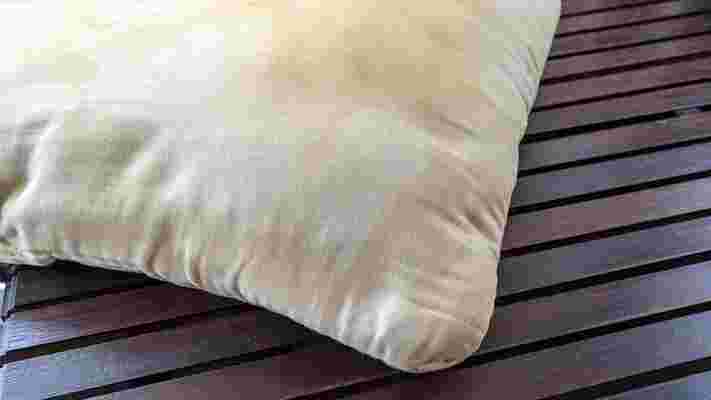
1. It will develop yellow stains
We’ve all been there. You’ve stripped your bed of its sheets only to find a large yellow stain on your pillow. But how did it get there? And just why do pillows turn yellow anyway? According to our research, there are few reasons why your pillow can discolour, but the main culprit is sweat.
“One does not want to imagine the number of substances and bacteria in the pillow if it is not regularly washed or protected,” Wilson adds. “Imagine coming in from a bike ride, hike or ride in a subway, and then laying your head down on your pillow without washing your face and hair first.”
2. The pillow will weigh more
Believe it or not, some experts say your pillow could weigh a kilo heavier if you leave them unwashed for a year. But why is that? Wilson has an answer: “Your pillow could weigh more now than when you first used it because of build-up within the pillow.
“A simple test is folding your pillow and if it remains folded when you remove your hand, it should be washed or replaced.” Personally, we’d replace any pillow that can be bent in half yet remains in that position and doesn’t spring back.
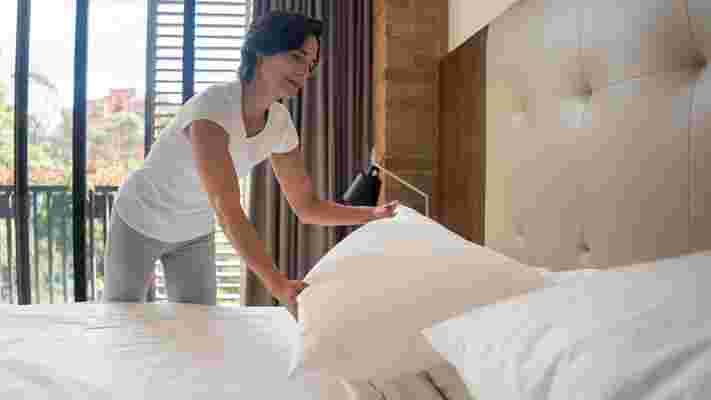
3. It will accumulate a lot of dead skin
One of the reasons why your pillow could weigh a kilo heavier? Because it’s packed full of dead skin – and this is completely natural for a product that comes into very close contact with the face, neck and head every night. A pillow protector can help tremendously here, and they can be washed more easily than an actual pillow.
But don’t just take our word for it – a 2011 study published in the Environmental Science & Technology journal found that we shed between 0.03 and 0.09g of skin each hour. And, with the average person spending around one-third of their life sleeping, that’s a whole load of skin we’re leaving behind on our pillows that aren’t washed regularly.
4. Dust mites will take up residence
Unfortunately, dust mites can be found in pretty much every home. From your mattress and curtains to your carpets and even your clothes. These little critters feed off dead human and animal skin cells and get their supply of water from humid air.
And – as we’ve just seen – our pillows have a lot of dead skin for them to feast on. That’s just one reason why it’s so important to keep your pillows, ned and surrounding areas squeaky clean.
So how can we protect against dust mites? “We recommend that you create a sleep experience focused on ‘protect and prevent’,” Wilson advises. “Protect by using pillow protectors so that you do get stains in the first place. And this protection will also prevent significant exposure to allergens.”
5. The pillow will be packed with your body oils
Hands up if you moisturise before you go to bed? Yes, us too. Now throw in facial oils, serums, ointments and various products you’ve used on your. Don’t use any of that stuff? Ok, but you’ll still be producing natural body oils and those will get trapped within your pillow too.
While all the above are not intended to be splayed across your pillow, it’s inevitable that some amount of these products will end up seeping into wherever you lay your head. And, along with sweat, these fluids and forms of moisture can contribute to making your pillow yellow and smelly.
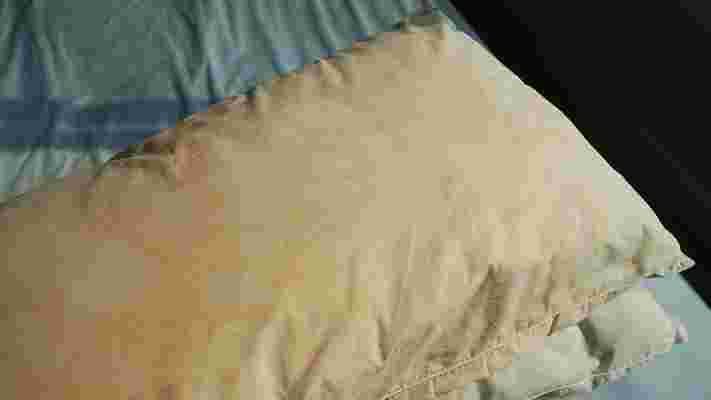
6. Allergens can seep in
Allergens, such as dust, are substances that trigger an allergic reaction. Dust, as we know it, usually consists of dead skin cells, hair, dust mites and their faeces, bacteria, viruses, mould and more. Since most of these are microscopic in size, we might not be able to see them via the naked eye, but that doesn’t mean they’re not there.
“While you sleep, your pillow absorbs dead skin cells, body oils, sweat, as well as allergens,” says Danielson. “While you should swap out your pillowcases weekly, a full cleaning of the pillow every three to six months will remove lingering stains and keep it clean of allergens and dust.”
7. Your pillow’s lifespan will be cut short
Generally speaking, the lifespan of a pillow is usually one to two years, depending on how well you protect and care for it. However, if your pillow goes unwashed, it’s lifespan could be cut in half. That will cost you more money in the long-term if you keep having to replace dirty, smelly pillows.
“Washing will not only help reinvigorate the fill materials, but will also extend a pillow’s lifespan.” Danielson tells us. “While you should swap out your pillowcases weekly, a full cleaning of the pillow every three-six months will remove lingering stains and keep it clean of allergens and dust.
“If instructions are not followed, you may see a degradation of comfort or quality over time. Proper cleaning helps to maintain the lifespan of your pillow.”
Why you should wash your pillow regularly
So there you have it: seven solid reasons to get that pillow washed as soon as possible. If you don’t have the time right now, consider investing in a good pillow protector to place a barrier between your face and the unwashed pillow.
While we’re on the subject, do you have protection for your mattress? If not, take a look at our best mattress protectors guide for inspiration. You can also learn more about cleaning beds and bedding in our step-by-step guide to how to clean a mattress.
This article is part of TechRadar's Sleep Week 2022 (running from Sunday 13 to Saturday 19 March), a week-long celebration of all things slumber. We'll be bringing you proven techniques and tips to help you sleep better, and have rounded-up all the top-rated tech to transform your sleep.
With the release of iOS 15.4 and watchOS 8.5 , Apple has finally made it easier to restore your Apple Watch without having to take it to an Apple Store for a Genius appointment.
Since its first release back in 2015, if you had an issue with your Watch where a factory reset wouldn't solve the issue, there was no direct port to plug in a lightning cable to restore from iTunes - similar to what you would do with an iPhone , iPad or iPod touch .
A trip to an Apple Store close by to book a Genius appointment would be the only option, where their tech support would be able to forcibly restore your Watch through a secret data port.
But with iOS 15.4 and watchOS 8.5, this can be done anywhere , saving you a long trip and a headache.
Analysis: A long time coming
The ability to restore your own iPhone has been the standard since the first iPhone in 2007.
But while the Apple Watch has always had a secret data port that's at the bottom of the smartwatch, it's a port that's never been intended for consumer use, only by Apple. You would go to an Apple Store, see its tech support, or Genius as they're called, and they would be able to use this port to reset your Watch.
However there are situations where an Apple Store could be hundreds of miles away, and you've got a paperweight on your wrist. This is why it's a relief to have this feature in iOS 15.4 and watchOS 8.5.
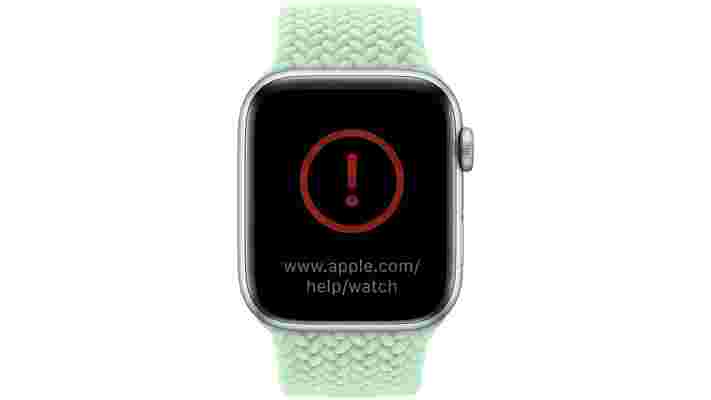
All you need to do is place the Watch on a charger, press the side button twice, and a pop-up should appear on your iPhone, explaining that it's discovered an Apple Watch that needs to be restored.
After a half hour, the Watch will appear as though it's being used for the first time, and you can start to pair it to your iPhone again.
This is going to be a great help for many, and will reduce the stress at least in trying to find time to go to an Apple Store to do this.
Leave a Comment